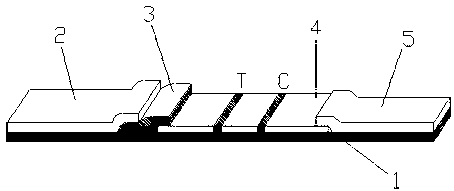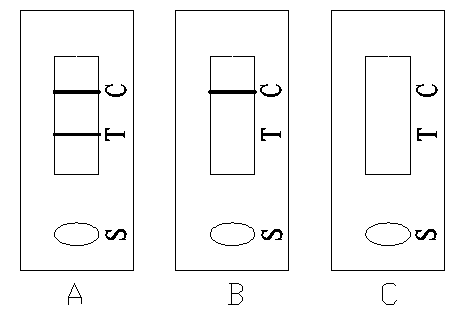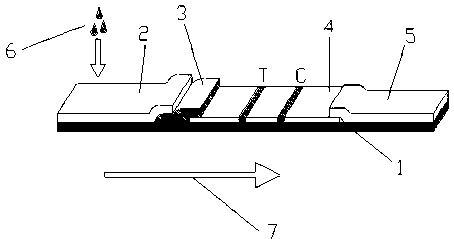Application of CRISP1 (cystein-rich secretory protein 1) test paper for diagnosing gingival carcinoma
A technology of cysteine and secreted protein, which is applied in the analysis of materials, biological tests, material inspection products, etc., can solve the problem of inconclusive range of palatal gingiva, and achieve convenient disease self-monitoring, good stability, and rapid detection Effect
- Summary
- Abstract
- Description
- Claims
- Application Information
AI Technical Summary
Problems solved by technology
Method used
Image
Examples
Embodiment 1
[0011] The specific embodiments provided by the present invention will be described in detail below in conjunction with the accompanying drawings.
[0012] The reference signs and components involved in the accompanying drawings are as follows:
[0013] 1. Bottom plate 2. Sample pad
[0014] 3. Gold pad 4. Nitrocellulose membrane layer
[0015] 5. Absorbent paper layer 6. Saliva
[0016] 7. Chromatographic direction
[0017] Example 1 Immunohistochemistry
[0018] Experimental materials: normal gingival tissue and gingival cancer tissue; the primary antibody is goat anti-human CRISP1 antibody, and the secondary antibody is donkey anti-goat Dylight594 antibody.
[0019] experimental method:
[0020] Tissue chip is the orderly combination of a large number of tissue samples on the surface of a micro-substrate, with the help of immunohistochemical method for detection.
[0021] 1. Fix the tissue with PFA fixative for 5 minutes, wash with PBS for 10 minutes
[0022] 2. Anti...
Embodiment 2
[0037] Example 2 Enzyme-linked immunosorbent assay (Elisa)
[0038] A total of 90 cases, including 30 cases of gingival cancer (squamous cell carcinoma) case group; 30 cases of other oral diseases (periodontal disease, pulp disease, oral candidiasis) group; 30 cases of healthy control group. The cysteine-rich secreted protein detection kit is used for detection, and the detection steps refer to the instruction manual of the cysteine-rich secreted protein quantitative enzyme-linked detection kit.
[0039] ELISA detection results of CRISP1:
[0040] 1. The gingival cancer group was higher than the other two groups, while there was no difference between the other disease group and the healthy group (P=0.802).
[0041] Table 1 The diagnostic value of saliva CRISP1 in the diagnosis of gingival cancer
[0042] diagnostic index AUC sensitivity specificity false positive rate false negative rate Youden Index Urine CRISP1 10 ng / ml 0.829 86.5% 41.3% 60.7...
Embodiment 3
[0045] Example 3 Preparation of gold-labeled antibody complex on test paper
[0046] 1. Colloidal gold preparation
[0047] Add 100ml of 0.005%-0.02% chloroauric acid solution into a round bottom flask and heat to boiling. After boiling, add freshly prepared 0.4%-2% trisodium citrate (Na 3 C 6 h 5 o 7 2H 2 O) 1-2.2ml of aqueous solution, after boiling for 10-25 minutes, continue to stir and cool to room temperature. During this process, it can be seen that the color change of the solution is: golden yellow→black→purple→dark blue→bright red. When the color of the solution completely changes to transparent bright red, the required colloidal gold is obtained. After cooling, put it into a dialysis bag and dialyze it against ultrapure water (1:5000) three times, and finally transfer the dialyzed colloidal gold to a clean glass bottle with a screw cap, and store it in a dark environment at 4°C.
[0048] 2. Connection between gold colloid and protein
[0049] 1. The adsorption...
PUM
 Login to View More
Login to View More Abstract
Description
Claims
Application Information
 Login to View More
Login to View More - R&D
- Intellectual Property
- Life Sciences
- Materials
- Tech Scout
- Unparalleled Data Quality
- Higher Quality Content
- 60% Fewer Hallucinations
Browse by: Latest US Patents, China's latest patents, Technical Efficacy Thesaurus, Application Domain, Technology Topic, Popular Technical Reports.
© 2025 PatSnap. All rights reserved.Legal|Privacy policy|Modern Slavery Act Transparency Statement|Sitemap|About US| Contact US: help@patsnap.com



